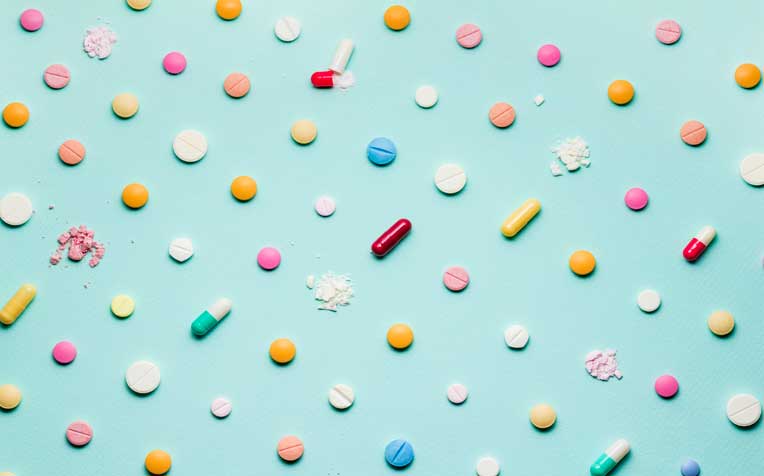
Drug interactions can cause serious side effects or result in failed therapy.
A drug interaction can be defined as an interaction between a drug and another substance that can decrease or increase the effectiveness of the drug, or results in augmented side effects of drugs.
Drug interactions can be categorised into 3 groups:
- Interactions of drugs with other drugs (drug-drug interactions),
- Drugs with food (drug-food interactions)
- Drug with disease condition (drug-disease interactions).
It is important to know the possible drug interactions as these can cause serious adverse reactions or result in failed therapy.
Drug-drug Interactions
Drug-drug interactions result when two or more drugs react with each other. Such drugs can be from a combination of prescription drugs and/or over-the-counter (OTC) medications. Drugs with a narrow therapeutic range (little difference between therapeutic and lethal dose) are more likely to face incidents of serious drug interactions.
For example: Taking digoxin with antibiotics like erythromycin or clarithromycin will increase the toxicity of digoxin because antibiotics affect the liver enzymes, causing digoxin to be metabolized (inactivated) slower. Similarly, the concurrent use of methotrexate and ibuprofen may result in increased methotrexate toxicity due to inhibition of kidney excretion by ibuprofen.
The effectiveness of drugs may be reduced in situations where the action of one drug diminishes the action of the other. Some antibiotics reduce the effectiveness of oral contraceptive pills by impairing the bacterial flora responsible for recycling the hormone from the gut. Also, drugs like charcoal or magnesium carbonate should preferably not be taken at the same time as other drugs as they may impair absorption.
Side effects of medications are intensified when drugs with the same effect are taken together. For instance, taking codeine (painkiller) with a cough syrup like procodin will increase the sedative effect. Aspirin, which is anti-platelet, increases the risk of bleeding when given together with warfarin, heparin or anti-depressants. There is also an increased risk of hepatotoxicity (liver damage) when isoniazid and paracetamol are used together.
Drug-food interactions
These interactions occur when drugs react with foods, dietary supplements or beverages (including alcohol). Some drugs may interfere with the body’s ability to absorb nutrients. In the same way, certain herbs and food can lessen or increase the impact of a drug.
Smoking and drinking habits can have an adverse effect on drugs. Consumption of alcoholic drinks while on the antibiotic metronidazole will cause skin flushing, nausea, headache, and palpitations. Alcohol enhances the hypoglycaemic effect of anti-diabetic medication, and the hypotensive effect of many blood pressure drugs. It is best to avoid alcohol while on medications.
The tobacco in cigarettes can also diminish the effectiveness of medications by increasing drug metabolism. Caffeine, which is found in tea, coffee, soft drinks and chocolate and some medications, can increase the risk of theophylline (a drug to treat asthma) toxicity.
Certain foods cause drug interactions. People on warfarin have to avoid eating large amounts of green leafy vegetables like broccoli, spinach and watercress because the high vitamin K content of these foods counters the effect of warfarin.
Grapefruit juice enhances the effect of drugs like simvastatin, nifedipine and ciclosporin, and its consumption should best be avoided. Dairy products which contain calcium reduce the absorption of biphosphonates, oral iron, levothyroxine and certain antibiotics e.g. ciprofloxacin and tetracycline.
As for herbal or dietary supplements, there are some reports of interaction between warfarin and herbs such as garlic, Danshen, Dong Quai, ginseng, and ginkgo. These herbs may augment or reduce the effect of warfarin.
Drug-disease interactions
Drug-condition interactions occur when a drug worsens or exacerbates an existing medical condition. For example, a nasal decongestant containing pseudoephedrine increases blood pressure and thus has to be avoided by people who are hypertensive (have high blood pressure).
Asthmatic patients should be careful when using/buying over-the-counter NSAIDs like ibuprofen as they may cause airway constriction.
Always inform your doctor about your condition/disease before the doctor prescribes a new drug. Conditions that place patients at high risk for drug interactions include kidney or liver disease, diabetes, asthma, cardiac problems, epilepsy, high or low blood pressure. Drug-disease interactions are more common among the elderly, who tend to have more diseases.
In conclusion, people should inform healthcare professionals of their condition and any medications/dietary supplements that they are taking when visiting the doctor or purchasing medicines at the pharmacy. If a drug interaction is unavoidable, the patient will need to monitor the safety and efficacy of the drugs.
What you can do to avoid adverse effects from drug interactions?
- Know your own medicines. When you visit a doctor, inform them about all the drugs you are taking, or have taken within the last few weeks. This should include over-the-counter medications, vitamins, dietary supplements, and herbal remedies.
- Keep your list of medications up to date. This is particularly important if you visit more than one doctor or pharmacy.
- Ask for what to avoid. Your doctor/pharmacist can advise if there are any medications/food/ beverages to avoid when you start any new medication.
- Follow instructions. Take drugs as instructed by healthcare practitioners and learn about the possible side effects of these drugs. Report any side effects or problems with your medications.
- Review your medications regularly. Have your medication reviewed regularly and work with your healthcare practitioner to eliminate unnecessary medications because the likelihood of drug interaction increases with the number of drugs you take.
References:
http://www.merck.com/mmhe/sec02/ch013/ch013c.htmlhttp://www.medicinenet.com/drug_interactions/article.htm
Ref: V10
Contributed by














 Get it on Google Play
Get it on Google Play